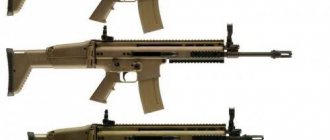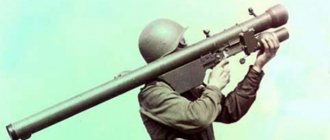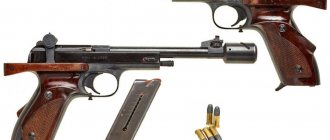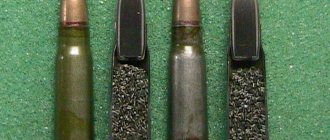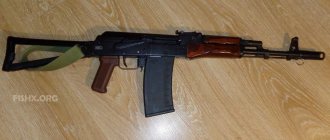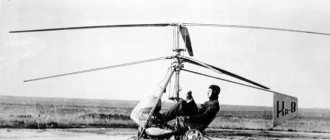In 1941-1942, the German army was faced with the problem of a shortage of infantry anti-tank weapons, capable of fighting Soviet medium and heavy tanks. Neither the 37-mm PaK 35/36 guns, nor the 47-mm Czechoslovakian PaK(t) guns, nor even the new German 50-mm PaK38 guns fully justified the hopes placed on them. Perhaps the only universal weapon against Soviet tanks was the 88-mm FlaK 18 anti-aircraft gun, but it was massive and immobile.
The appearance of powerful anti-tank 75-mm and 88-mm guns (PaK 40 and RaK 43, respectively), as well as a large number of captured guns (mostly 76.2 mm Soviet) somewhat corrected the situation. The idea arose to install one of these guns on a self-propelled platform. Since it took time to create and commission full-fledged combat vehicles, improvised self-propelled guns, created on the basis of captured guns and chassis, first appeared.
The 76.2-mm self-propelled gun “Marder” II (chassis Sd Kfz 132) from the anti-tank units of the German 4th Tank Army is moving to the front line. Eastern Front, July 1942.
The first such “conversion” was a self-propelled unit that combined the German 75 mm PaK 40 L/46 gun and the French Lorraine tractor (a fully armored tracked vehicle used by its former owners as armored personnel carriers and artillery tractors). The Germans gave tractors a new name - “Lorraine Schlepper”.
The creator of the project was engineer Alfred Becker, who during the campaign in the West of 1940, with the rank of captain, commanded an artillery battery in the 227th Infantry Division, and then headed his own company in Krefeld, which, on its own initiative, had already been engaged in a similar “conversion.”
History and production[edit]
In 1963, the main battle tank Leopard 1 was adopted by the Bundeswehr. In 1964, motorized infantry appeared on amphibious American M113 armored personnel carriers, designed to conduct combat operations at a high tempo, with crossing water obstacles on the move. By the beginning of 1967, 14 tank battalions were transferred from M47 tanks to Leopard 1. The HS-30 armored personnel carrier could no longer solve the problems of interaction with Leopard 1 tanks, which had a speed of up to 70 km/h, and its capacity was less than the size of the motorized infantry squad - 10 Human.
In parallel with the Leopard 1 tank, the development of an infantry fighting vehicle of the Neu project was carried out - “new” for joint actions. Moreover, not only the combat properties of the tank and infantry fighting vehicle were agreed upon, but also issues of logistics and technical maintenance. The BMP was designed by the same companies that created Leopard 1 - Rheinmetall and Henschel-Werke. The development of the BMP took 9 years. The first samples were shown in 1960 - 1961. The final version was chosen in 1966, and at the beginning of May 1969, the BMP was presented to the military leadership at the Munster training ground. The car was called "Marder". 1.8 billion marks were allocated for production. Rheinmetall was chosen as the general contractor - in Kassel, the second in Kiel. Production began in late 1969 and was carried out on two assembly lines at an average rate of 55 units per month. Until 1975, the companies produced 1,759 and 977 infantry fighting vehicles, respectively.
Construction[edit]
Armored hull and turret[edit]
The armored body is welded from steel sheets up to 30 mm thick and completely sealed (personnel can stay inside the vehicle for 24 hours). The tower is of a welded structure, made of steel armor, and the level of protection can be enhanced. The stern plate has a door that allows for quick landing and disembarkation of troops while the vehicle is moving.
In 1988, a program was launched to modernize the vehicle to the A3 level, under which the Thyssen-Henschel company received a 10-year contract to upgrade 2,100 Marder 1 A1/A2 series vehicles to the A3 level at a rate of 220 vehicles per year. The first batch of Marder 1 A3 entered service with the ground forces on November 17, 1989. The intended purpose of the program is to ensure that infantry fighting vehicles are indestructible in the forward sector of fire from armor-piercing sub-caliber projectiles of the 30-mm 2A42 cannon, the main armament of the Soviet BMP-2. The modernization of the infantry fighting vehicle included: modification of the hull and turret with the installation of additional passive protection with a total mass of 1600 kg (while the total mass of the vehicle increased by 5.5 tons), in particular, a 10-mm steel sheet-screen on the VLD with the formation of a spaced barrier, conformal hinged armor linings on all sides of the turret, longitudinal box-shaped armored structures of trapezoidal cross-section on both sides of the hull, and additional roof armor for protection against cluster munition combat elements.
The vehicle's capacity is 10 people, including three crew members, two of whom (commander and gunner) are in the turret, and the driver is in front of the hull on the right. The fighting compartment is located in the middle part of the hull.
Weapons[edit]
The infantry fighting vehicle is armed with a 20 mm RH 202 automatic cannon and a coaxial 7.62 mm MG3 machine gun mounted on a carriage on top of a two-man turret. The Rh 202 cannon is loaded with 20x139 mm cartridges. Another 7.62 mm MG3A1 machine gun is located on the roof of the troop compartment and has a remote control. In 1979, an experienced Marder with a turret stabilized in three planes was tested.
For the Marder 2 double turret, Rheinmetall AG developed the Rh 503 gun with an interchangeable 35 and 50 mm caliber barrel and elements of the feed mechanism. The gun has electromechanical drives for the reloading system, a variable rate of fire of 150 and 400 rounds/min, and double-sided linkless power supply. The 35 mm barrel was supposed to be used for training purposes, and the 50 mm for combat purposes. A 7.62 mm machine gun is paired with the cannon. Also, a Panzerfaust 3 grenade launcher with a firing range of up to 1,000 m can be mounted on the left side of the turret, but firing from it requires stopping, the grenade launcher exiting the vehicle, and removing the RPG from the mount. Therefore it is used very rarely.
Surveillance and communications equipment[edit]
According to German tradition, the Marder is abundantly equipped with surveillance devices. In addition to three prism blocks, the driver has a removable illuminated night vision device that operates at a distance of up to 50 m. While driving, he uses two folding rearview mirrors. There are 8 observation blocks installed along the perimeter of the commander’s cupola. The gunner has at his disposal three prism blocks installed on the left side of the tower at the junction with its roof. Each shooter has his own prism viewing block. On the left side of the carriage, an infrared and white light spotlight is mounted on a special rod, operating at a distance of up to 800 and 1000 m, respectively. Two headlights are installed in front on the front plate. Reflectors and side lights are installed at the stern. The latter are located so that, based on the degree of their visibility, the driver of the car behind can determine the distance while marching at night or in fog. The BMP's fire control system includes a new commander's day/night sight with a built-in thermal imager and laser rangefinder, a gunner's sight and an electronic ballistic computer.
Engine and transmission[edit]
The engine and transmission compartment is equipped with a four-stroke six-cylinder V-shaped multi-fuel diesel engine MV833 Ea-500 with turbocharging. Power 600 hp at 2200 rpm, compression ratio - 19.5. Three fuel tanks with a total capacity of 652 liters are installed in the combat and troop compartments. This is enough for 520 km of highway travel, and up to 600 km on good German roads. Lubrication system - dry sump. The HSWL-194 Renk hydromechanical transmission, installed in front of the engine, includes a hydrodynamic transformer and a hydrostatic gearbox mounted in a single unit. The gearbox is planetary, with a torque converter at the input and a reverse mechanism. The presence of a torque converter reduces the load on the parts and components of the transmission, but at the same time it has low efficiency, produces additional heat and reduces the power reserve, so it is turned on only for starting, in difficult road conditions and when changing gears, and is blocked in other modes. The gearbox provides 4 forward and reverse gears, shifting is carried out by an electro-hydraulic drive.
Chassis[edit]
Tracks with rubber-metal hinges, torsion bar suspension with hydraulic shock absorbers. When creating the chassis, elements of the chassis of the Leopard 2 tank were used. Control was done with a car-type steering wheel. The stepless turning mechanism allows you to quite smoothly change the turning radius of the machine. A torque converter, planetary steering mechanisms and servos greatly facilitate the driver’s work.
The marder is equipped with air conditioning and fire-fighting equipment with two double-extinguishing cylinders - the first is activated by a signal from temperature sensors, the second by a manual switch on the control panel. The vehicle is powered by a 9 kW generator and six batteries with a total capacity of 300 Ah, the on-board voltage is 24 V. There are tow hooks with locks on the lower glacis plate and the stern, and a handrail bracket above the stern door to facilitate landing.
Self-propelled gun "Marder" III
In March 1945, the Wehrmacht and SS troops still had more than 300 self-propelled guns of this type.
The next chassis, on the basis of which self-propelled anti-tank guns of the “Marder” series , was the chassis of a captured Czech light tank, which had the German designation Pz 38(t). Self-propelled guns on this base became the third generation of “Marder” and were unofficially called “Marder” III .
In March 1942, at the plant of the Prague company VMM, serial production of a new self-propelled gun began, designated “Panzeijager 38(t) fur 7.62 cm PaK 36(r)” (Sd Kfz 139). This vehicle was a Pz 38(t) chassis armed with the already familiar Soviet 76.2 mm F-22 gun.
The fixed, semi-open cabin of the installation (the thickness of the armor plates was 10 mm) protected the gun crew only from bullets and shrapnel. The gun was slightly shifted to the front of the hull. During movement, the gun barrel was secured with a clamp mounted on the roof of the control compartment. The vehicle had a silhouette that was too tall for its size - 2.5 m. Its weight increased significantly, which forced savings on the armor protection of the self-propelled gun. Moreover, the gun crew, sitting on folding seats, was practically in full view of the enemy.
Anti-tank 75-mm self-propelled guns Marder III Ausf M (Sd Kfz 138) during exercises. Northern France, 1944.
The production rate of self-propelled guns was not high. In total, during the period from March to November 1942, 344 self-propelled guns were produced.
A number of these vehicles ended up in North Africa, and they fought as part of the Afrika Korps units until the complete defeat of the Axis forces in Tunisia. When the British first encountered the Marder III with Soviet 76.2 mm guns, they assumed that they were dealing with self-propelled 88 mm guns.
The Marder III self-propelled guns on the Eastern Front in April 1942, where they quickly proved their effectiveness. They were in service with anti-tank divisions as part of tank and motorized divisions. In fact, until the appearance of Pz IV Ausf F 2 tanks with long-barreled guns at the front in significant numbers, these self-propelled guns were the most effective means of combating the Soviet T-34 and KV-2. The Marder III (Sd Kfz 139) self-propelled guns in combat operations until the end of 1943.
“Marder” II and “Marder” III line are in many ways similar. If the first versions of both generations had the Soviet F-22 divisional gun as a weapon, then the second - the German 75-mm RaK 40 anti-tank gun.
In May 1942, the Tank Forces Logistics Directorate ordered the adaptation of the RaK 40 gun to the chassis of the Czechoslovakian Pz 38(t) tanks. - “master of conversions” - produced a prototype, which was positively assessed by representatives of the high military command.
Serial production of the self-propelled gun, designated “7.5 cm RaK 40/3 auf Fahrgestell des Pz Kpfw 38 (t),” was carried out by the Prague VMM plant. From November 1942 to June 1944, the Czechs produced about 1,250 vehicles. Later, more than 300 chassis and damaged Pz 38(t) tanks were converted into self-propelled guns at a repair facility in the Czech town of Prilougi.
"Marder" III Ausf N - "Heckmotor"
Self-propelled guns were produced in two serial modifications. The first version of the "Marder" III Ausf H ( "Heckmotor" - "engine compartment in the stern") was based on the original chassis of the Czech tank. The gun crew was protected by a high cone-shaped armored cabin located approximately in the middle of the hull. In November 1942 - April 1943, the VMM company produced 418 Marder III Ausf N self-propelled guns (of which 175 self-propelled guns were converted directly from Pz 38(t) linear tanks).
"Marder" III Ausf M - "Mittemotor"
Another modification is the “Marder” III Ausf M ( “Mittemotor” - “engine compartment in the middle”). Serious changes have occurred in the design of the hull and in the location of the main compartments of the machine. The power plant was moved to the central part, and the armored cabin was moved to the stern. Thanks to this rational layout, the self-propelled guns turned out to be more stable. Reducing its length and height had a beneficial effect on cross-country ability and maneuverability. Conditions for gun crews have improved. The reduction of some parts of the riveted structure of the hull significantly simplified its mass production. From April 1943 to June 1944, 975 Marder III Ausf self-propelled guns were produced. M.
Forming the basis of the anti-tank divisions of German tank and motorized divisions in 1943-1944, Marder III , armed with 75-mm guns, earned a reputation as the best light anti-tank self-propelled guns until the advent of the Hetzer tank . They took part in hostilities on all fronts: in Russia, Tunisia, the Western Front and Italy. On the Eastern Front, these self-propelled guns were actively used during the battle of Kursk, in bloody battles in the countries of South-Eastern Europe (Czechoslovakia, Hungary).
Options and modifications[edit]
- SPz NEU
- ten pre-production samples produced between October 1968 and March 1969. Equipped with a six-cylinder multi-fuel Daimler-Benz MB833Ea engine (600 hp). - Marder
(after 1985 the name was changed to
Marder 1
) - the first production model, produced from 1970 to 1975 (a total of 2136 vehicles were produced). The ammunition load was initially 1,250 20mm rounds and 2,500 machine gun rounds. - Marder
with a MILAN ATGM launcher mounted on the turret. The modification was developed in 1975; between 1977 and 1979, ATGMs were installed on all 2,136 vehicles. The ammunition load includes six MILAN ATGMs. - Marder 1 A1
- a modernized version, developed in 1979 - 1980 and put into production in 1981 - 1982. The electromechanical turret rotation mechanism was replaced with a more powerful one. The 20-mm cannon was equipped with a selective power mechanism, allowing it to switch from firing high-explosive fragmentation shells to firing armor-piercing shells. A shot with an armor-piercing DM63 sub-caliber projectile was added to the cannon's ammunition load; in addition, the ammunition load was increased to 1,284 rounds (of which 317 were armor-piercing). It was planned to equip about 1000 vehicles with a passive infrared sight with a thermal imaging indicator, but in fact it was installed on 674 vehicles. - Marder 1 A1A3
- Marder 1 A1 with new SEM 80/90 radio. - Marder 1 A2
- a version of the modernization carried out in 1984 - 1991. - Marder 1 A2A1
- Marder 1 A2 with new SEM 80/90 radio. - Marder 1 A3
- modification of 1989. The armor mass was increased by 1,600 kg with the aim of: making the vehicle invincible in the front sector of the BPS shelling by 30-mm BMP-2 cannon shells; - to enhance the protection of horizontal surfaces (hull roof and turret) from damage by cumulative combat elements of cluster munitions through the use of spaced armor.
is a variant of the Marder 1 A3 with the new SEM 93 cryptographic radio.
is a modernized version of Marder 1 A3, developed in 2003 - 2004. Additional mine protection was installed, and the interior was completely changed in order to reduce damage to the crew and troops in the event of a mine explosion. During the modernization, 74 Marder 1 A3 vehicles were updated.
is a modernized version of Marder 1 A5, developed in 2010 - 2011. An air conditioning system, multispectral camouflage of the hull and electronic warfare systems are installed. About 35 units underwent modernization.
Self-propelled gun "Marder" I
By the beginning of the summer of 1942, through the joint efforts of Alfred Becker and a number of French factories, the technological base for the conversion production of self-propelled guns was prepared, designated 7.5 cm PaK 40/1 auf Geschutzwagen Lorraine Schlepper (f) (Sd Kfz 135). In the army, the car was nicknamed “Marder” (“Marten”) . Subsequently, this became the official name of a whole series of anti-tank self-propelled guns, and this first “Marder” received the serial number “I”. By the end of the year 1942, it was possible to produce 185 Marder 1 (48 were manufactured, the rest were manufactured by Alfred Becker in cooperation with French factories). The conning tower was located in the stern. Due to the overload of the Marder 1 chassis, it was necessary to equip it with weak bulletproof armor, the thickness of which did not exceed 12 mm. Therefore, initially, Marder I self-propelled guns served only in the German occupation forces in France as part of anti-tank battalions of infantry divisions. However, some vehicles fought on the Eastern Front and in Italy in 1943-1944. But this was rather an exception.
75-mm self-propelled gun Marder II (based on Sd Kfz 131) at a field exhibition of weapons and equipment. Northern sector of the Eastern Front, summer 1943.
On January 1, 1944, there were 131 self-propelled guns in France. In Normandy, Marder I had to take an active part in fierce battles with the Allied forces landing there in the summer of 1944. On July 2, 1944, Major Becker was awarded the Knight's Cross for the brilliant leadership of his battalion during the Battle of Caen. The stubborn resistance of his units prevented Allied units from capturing the city on the move in June 1944.
By the end of August 1944, all Marder I self-propelled guns were destroyed or abandoned due to lack of fuel and ammunition.


